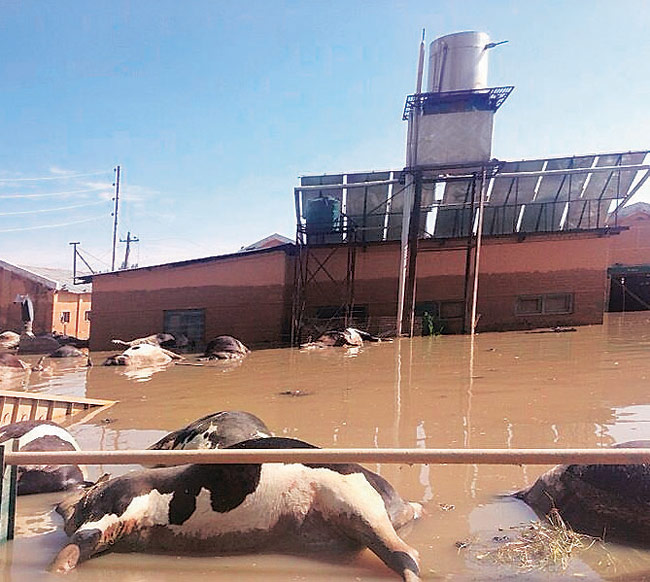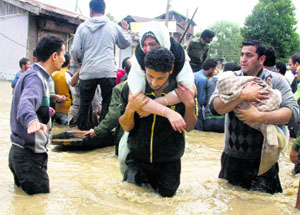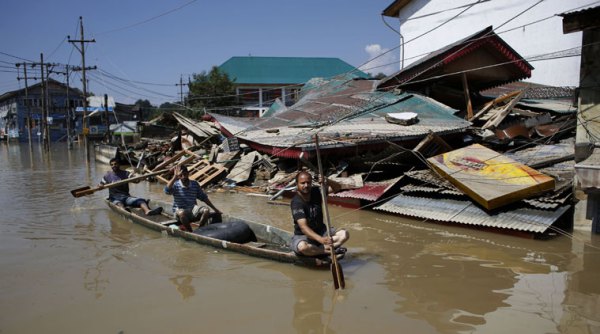People of Kashmir face raising health risk, serious disease
Srinagar, Sep 18, 2014: The floodwaters are finally receding in much of Kashmir, but health experts worry a crisis could be looming with countless bloated livestock floating across the waterlogged region and hundreds of thousands of people living in temporary shelters.
receding in much of Kashmir, but health experts worry a crisis could be looming with countless bloated livestock floating across the waterlogged region and hundreds of thousands of people living in temporary shelters.
Doctors have already seen cases of diarrhoea, skin allergies and fungus, and are worried that the stagnant waters are creating conditions for the outbreak of serious diseases. "The chance of cholera, jaundice and leptospirosis spreading are high," said Dr. Swati Jha with the aid group Americares. "The most essential need right now is that of clean water."
"We are all feeling sick over here because of the overpowering smell of dead cows. No one is removing them from here," resident Ghulam Qadir Mir, 55 in Srinagar said.
Several animal carcasses are still floating in the city, while more than 75,000 people are still living in submerged colonies.
Although, water levels have decreased, threat of water-borne diseases remains  extremely high, according to medical experts.
extremely high, according to medical experts.
Qamarwrai, located three kilometers north to Lal Chowk, the centre of Srinagar city, still remains submerged in water, but municipality workers are still missing in action.
Stagnant canals filled with wreckage, trash and dead animals is floating around the city and garbage piled in drier areas has not been removed. Medical experts said if relief work does not begin at the earliest, more than five lakh residents of Srinagar are facing an inevitable threat of water-borne diseases.
Doctors in Soura Institute of Medical Sciences in Srinagar, one of the two state run hospitals presently functional in the capital which is catering to the population of Srinagar and the rest of Kashmir valley, said the inflow of patients could increase in coming days as the number of flood affected patients have started trickling from other areas too.
"We have treated more than 18,000 patients in nine days, majority of them complained of respiratory and gastroenteritis problems," Dr Showkat Ali Zargar, Director of Soura Institute of Medical Sciences, told media men. As the water levels still remain high in many parts of Srinagar and in south Kashmir, residents have been complaining of respiratory track infection, caused mainly due to stagnant water, doctors said.
 Zargar added that the influx of patients from the flood-affected areas has increased and on an average his hospital receives more than two thousand patients now. "The problem of stagnant flood waters should be immediately solved. If not it could lead to an epidemic," he said.
Zargar added that the influx of patients from the flood-affected areas has increased and on an average his hospital receives more than two thousand patients now. "The problem of stagnant flood waters should be immediately solved. If not it could lead to an epidemic," he said.
Thousands of people have been rendered homeless and anger. Hundreds of people blocked the highway near Bemina and demanded immediate help and pumps so that water from the colonies could be removed.
" Our homes will collapse in few days," Firdous Ahmad, a resident of Gousia colony of Bemina, said.
"The Srinagar Municipal Committee (SMC) has failed to even remove the dead animals from water. How can we move back to our house," Tariq Jameel, 42, who along with his family lives on a divider in Tangpora area of Srinagar, said.
Around 1,200 villages in the Kashmir valley and 1,100 in Jammu region have been affected, around 400 villages have been totally submerged.
Fayaz Hamed, a local aid worked in Srinagar, said that when he arrived in one submerged neighbourhood on Monday night the smell of rotting flesh was overwhelming. “It was an overpowering stench, and we saw local residents pulling two bodies [of people] out of the water,” he said.
At least 80% of the main city of Srinagar was still under more than three or four metres of water on Tuesday, with most residents now staying in shelters or with relatives on higher ground.
The floods have also had a huge impact on communications and mobile phone services have only been restored in recent days. “After the floods, the second disaster came when telecommunications broke down,” said local school teacher Reyaz Qazi, who had two telephones in continual use on Tuesday trying to reach any of his 10 relatives and friends who were missing.
Critical care specialist Dr Javaid Naqishbandi said in Srinagar,: “There are pretty high chances of waterborne disease and disease due to overcrowding.”
"With our health infrastructure lost, any disease can be catastrophic now. You don't need any plague for mass deaths," said critical care specialist Dr. Javaid Naqashbandi while scribbling out a prescription for treatment of stomach illness on the patient's hand.
Naqashbandi and other doctors working out of the small, private Ahmed Hospital on the outskirts of Srinagar said they already had treated dozens of patients for gastroenteritis, as well as delivering at least 88 babies by cesarean.
In some critical cases, all they could do was keep patients stable, such as 60-year-old Abdul Rashid Wani, who fractured his spine in falling on the second day of the floods while he was taking shelter on a high veranda.
"We thought we had lost our father. But the hospital has revived him, for now," Wani's son Ishfaq Ahmed said.
Rescue workers were wearing masks to avoid disease contamination. Local aid worker Fayaz Hamed said he visited one submerged neighborhood of Srinagar on Monday night where the air was filled with the smell of rotting flesh.
"It was an overpowering stench, and we saw local residents pulling two bodies (of people) out of the water," Hamed said. www.sahrja.com